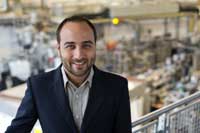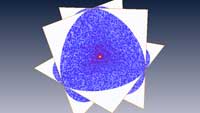High-powered research: physicist Adrian Mancuso Inspire article
Physicist Adrian Mancuso works at the cutting edge of 3D imaging, at what will be Europe’s newest and brightest X-ray facility.

Image courtesy of European
XFEL
The use of 3D imagery has gone beyond the gimmickry of monsters leaping out to scare you in the cinema. Today, using ultrahigh-powered X-rays instead of light, it’s being used to yield precise knowledge of the shape of molecules.
At the European X-ray Free Electron Laser (European XFEL)w1 in Hamburg, Germany, this knowledge could, in a few years, enable new drugs to be tailor-made to control diseases.

the experiment hall of
European XFEL
Image courtesy of European
XFEL
Working at the forefront of X-ray 3D imaging is physicist Adrian Mancuso, a scientist with a life-long curiosity about all aspects of the physical world. As a child, Adrian was an avid observer of the natural world and a keen reader of science books, which started him on the path to his current position as a leading scientist at the European XFEL, a giant X-ray laser that is currently under construction.
“What we’re trying to do is make high-resolution 3D images of biological molecules, as well as of other materials, so we can better understand how they work,” says Adrian. “In particular, we’re trying to image the kinds of molecules that can possibly only been seen with an X-ray laser.”
So how did a physicist like Adrian find himself working on biological molecules? He says: “I took a physics PhD that focused on how to use laser-like X-rays for imaging – really exploring the methods of X-ray imaging. That background, and my subsequent experience of performing this kind of experiment, provided me with the right knowledge to design an instrument for X-ray diffractive imaging at the European XFEL.”

Which is exactly what he is now doing. Adrian says: “Right now I’m building an instrument to do a kind of X-ray imaging called single-particle imaging. These single particles can be anything from tiny crystals to biomolecules to novel materials that we want to understand the structure of. This work is fascinating, because it combines new ideas in physics and mathematics with state-of-the-art technology to produce practical, applied research that just might change the world around us for the better.”

the central building of
European XFEL will look. The
tunnels from which the laser
-like X-ray flashes are led to
the experiment stations will
end in the underground
experiment hall beneath the
main building. This will
house laboratories and
offices, seminar rooms, an
auditorium and a library
Image courtesy of European
XFEL
Adrian clearly enjoys his job, enthusing that “every day is different, fun and challenging”. His enthusiasm for research and physics goes back to his early years, as he recalls: “I was always naturally curious. I wanted to understand how things worked, how the Universe works. My parents helped feed that curiosity when I was young by giving me mountains of science books to read. I guess it kept me out of trouble!” Adrian’s curiosity became focused on physics when he found one of his father’s physics textbooks. “I read it from cover to cover. I just found it so interesting that there was so much to understand about the physical world around us.”
Adrian’s interests were encouraged at school too. “I was fortunate to have enthusiastic science teachers, who allowed and even encouraged me to use the physics lab out of hours, design experiments, test ideas – and occasionally break stuff.”
After he left school, Adrian studied for a science degree at the University of Melbourne in Australia, with a major in physics, followed by a PhD at the same institution. So although he has come halfway around the world, from Australia to Hamburg, to work at the European XFEL, he clearly feels it’s been a good move.“
There are very few places in the world where one can hope to image non-crystalline biomolecules well enough that the imaged structure may be useful for drug design, or practical applications,” he says. “The European XFEL is at the forefront of single-particle imaging research worldwide.”
Adrian also thrives in the international team environment at European XFEL, where the staff come from six continents and more than 18 countries. He believes that the cross-cultural interactions and opportunities to learn about different parts of the world from colleagues is a “wonderful bonus to the top-class work we get to do each day”. He explains: “People from different places sometimes see the world around us in different ways. These different perspectives can have a positive influence by diversifying how we think about things – which can be essential for solving scientific problems.”

simulated diffraction pattern
of a 3-phosphoglycerate
kinase molecule. This is a
representation of what
‘perfect’ diffraction data
collected at European XFEL
may look like
Image courtesy of Z Jurek and
B Ziaja (CFEL), and AP Mancuso
(European XFEL)
As well as being passionate about his research, Adrian feels it is important to convey the joys of science to a wider audience – and he has had plenty of fun in the process. From helping to put on a science show for junior students while he was at high school – which was so popular he became known as “the guy from the science show” – to inviting high-school students to see how science is done in universities and laboratories and what it’s really like to work in them, Adrian has been involved in sharing his enthusiasm for science at every stage of his career. He says he found the activities with students “very rewarding, as the students got a clearer picture of ‘doing’ science in practice, not just in the classroom”.
So what advice would Adrian give to a student wanting to follow in his footsteps? “A good start would be to study physics. If you want to make images of things, it helps to have some knowledge of optics – in our case, especially the strange but fun world of X-ray optics,” he says. “This is an increasingly popular field of research, as there is rapid progress in the use of bright, laser-like X-ray sources across the world.”
And he would have no hesitation in recommending the intellectual pleasures to be gained from a career in research. Adrian says: “That moment when you realise that you and your colleagues in the room are the only people on the planet that, at that moment, have observed something unique – that’s something that one always remembers.”
Web References
- w1 – The European XFEL is a research facility currently under construction in the Hamburg area of Germany. It will generate extremely intense X-ray flashes to be used by researchers from all over the world. XFEL is a member of EIROforum, a collaboration between eight of Europe’s largest inter-governmental scientific research organisations, which combine their resources, facilities and expertise to support European science in reaching its full potential. As part of its education and outreach activities, EIROforum publishes Science in School.
Resources
- To find out more about his work, read the abstract of a talk Adrian Mancuso gave at the recent EIROforum teacher workshop (‘Finding the structure of biomolecules using ultrabright, ultrashort pulses of X-rays’).
- To learn more about the EIROforum teacher workshop, see:
- Furtado Neves S (2012) Diving into research at the EIROforum teacher school. Science in School 22.





